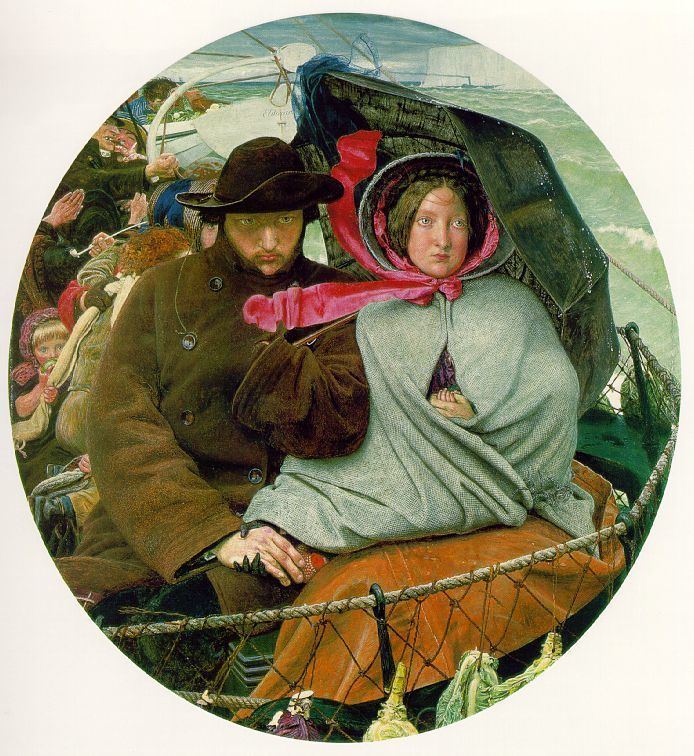Year 1855 Created 1855 | Medium Oil-on-panel Period Romanticism Genre History painting | |
 | ||
Dimensions 82.5 cm × 75 cm (32 in × 29 in) Similar Ford Madox Brown artwork, Artwork at Birmingham Museum and Art Gallery, Romantic artwork | ||
The last of england by ford madox brown
The Last of England is an 1855 oil-on-panel painting by Ford Madox Brown depicting two emigrants leaving England to start a new life in Australia with their baby.
Contents
- The last of england by ford madox brown
- Scene from the last of england
- Background
- Painting
- Provenance
- Popularity
- References
Scene from the last of england
Background
Brown began the painting in 1852 inspired by the departure of his close friend, the Pre-Raphaelite sculptor, Thomas Woolner, who had left for Australia in July of that year. Emigration from England was at a peak, with over 350,000 people leaving that year. Brown, who at the time considered himself "very hard up and a little mad", was himself thinking of moving to India with his new family.
Painting
Although Ford Madox Brown was never a member of the Pre-Raphaelite Brotherhood, The Last of England, like many of his paintings, exhibits all the characteristics of the movement. The painting depicts a man and his wife seeing England for the last time. The two main figures, based on Brown and his wife, Emma, stare ahead, stony-faced, ignoring the white cliffs of Dover which can be seen disappearing behind in the top right of the picture. The clothing indicates that family are middle class, so are not leaving for the reasons that would force the emigration of the working classes; Brown's writing touched on the same theme:
The educated are bound to their country by quite other ties than the illiterate man, whose chief consideration is food and physical comfort
The fair-haired child in the background behind the man's shoulder is Brown and Emma's child, Catherine, who was born in 1850. The hand of the baby, which can be seen clasped by the woman, is supposedly that of their second child, Oliver.
In order to mirror the harsh conditions in the painting Brown worked mostly outside in his garden, and was happy when the weather was poor — he recorded his feelings of delight when the cold turned his hand blue, as this was how he wanted it to appear in the painting. He was seen as strange by his neighbours who saw him out in all kinds of weather. He composed a short verse to accompany the painting in which the woman is depicted as hopeful for the future:
...She grips his listless hand and clasps her child,
Through rainbow tears she sees a sunnier gleam,
She cannot see a void where he will be.
Brown's painting room was above a china shop at 33 High Street, Hampstead and sittings took place in the house's garden. His diary noted that the '...ribbons of the bonnet took me 4 weeks to paint'.
Provenance
Two finished versions of the picture exist, one in Birmingham Museum and Art Gallery and the other in the Fitzwilliam Museum in Cambridge. A reduced watercolour replica of the painting in Birmingham produced between 1864–66 is in Tate Britain. A fully worked study also exists, and a detailed compositional drawing. All are in the form of round panels, a rarely revived Renaissance format called a tondo, but differ in colouring.
In March 1859 The Last Sight of England as it was then known, was sold by Benjamin Windus to Ernest Gambart for 325 Guineas (2010: £26,700).
Popularity
The picture was voted Britain's eighth-favourite picture in a poll carried out by BBC Radio 4. In 2013 it was voted 32 out of 57 paintings chosen by the British public from national collections, which were used for Art Everywhere The World's Largest Public Art Exhibition.
